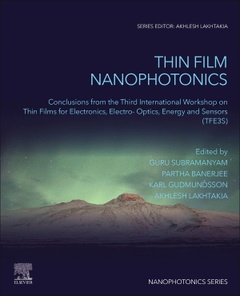Thin Film Nanophotonics Conclusions from the Third International Workshop on Thin Films for Electronics, Electro-Optics, Energy and Sensors (TFE3S) Nanophotonics Series
Coordonnateurs : Subramanyam Guru, Banerjee Partha P., Gudmundsson Karl S., Lakhtakia Akhlesh

Thin Film Nanophotonics: Conclusions from the Third International Workshop on Thin Films for Electronics, Electro-Optics, Energy and Sensors (TFE3S) provides up-to-date coverage of the properties and photonic applications of nanostructured thin films, including discussions on optical waveguides, photonic lattices for wideband reflectors, polarizers, bandpass filters, meta surfaces, plasmonic resonance sensors, smart windows, optical switches, photovoltaics, and many more. This is an important reference source for materials scientists, engineers and physicists working in the areas of nanomaterials and photonics.
New thin film applications such as thin-film topological insulators and 2D materials are gaining attention and growing exponentially, hence this book is an ideal reference on how engineered thin films for various nano-photonics applications present exponential growth in a wide array of areas.
Part I Basics 1. Optical propagation through metamaterial structures with multilayered metallo-dielectrics: Hyperbolic dispersion and transmission filters 2. Spectral characteristics of a thin lithographic tri-layer chiral slab resonator 3. Structural, electrical, and electromagnetic properties of nanostructured vanadium dioxide thin films 4. Photoactive ZnO nanostructured thin films modified with TiO2, and reduced graphene oxide 5. Orthotropic friction at the edges and interior of graphene and graphene fluoride and frictional anisotropy of graphene at the nanoscale
Part II Applications 6. Optical manipulation of nanoparticles with structured light 7. Design and nanophotonic thin film devices using phase change materials 8. Chromogenically tunable thin film photonic crystals 9. Thin-film solar cells with graded-bandgap photon-absorbing layer
Partha Banerjee is Professor and Chair of the Department of Electro-Optics and Photonics, and Professor of Electrical and Computer Engineering at the University of Dayton, USA. His research interests include digital and dynamic holography, photo refractivity, optical and acoustic metamaterials, nonlinear optics and acoustics, computational electromagnetics, and optical trapping.
Karl S. Gudmundsson (PhD) graduated from the Marine Engineering College of Iceland in 1984. He received his BS and MS degrees in computer engineering in 1996 and 1998, and his PhD in engineering, concentrating on electrical engineering, from Wright State University, in 2004. His research interests include theoretical and experimental, optical signal/image processing, classification, and tracking, optical computing algorithms, and architectures.
Akhlesh Lakhtakia is an Evan Pugh University Professor and The Charles Godfrey Binder (Endowed) Professor in the Department of Engineering Science and Mechanics, at Pennsylvania State University, USA. He received his BTech. (1979) and DSc (2006) degrees from Banaras Hindu University, India, and his MS (1981) and PhD (1983) degrees from the University of Utah, USA. His current research interests include electromagnetic and elastodynamic fields in complex materials and architected materials, including sculptured thin-films and mimumes, thin-film solar cells, biologically inspired design, and forensic science.
- Focuses on the interaction of photons with nanostructured thin films, nanocrystals, nanowires, semiconductor nanodots and photonic crystals
- Offers a comprehensive overview of the latest advances in thin-film nanophotonics
- Discusses how the properties of thin films make them particularly useful for photonic applications
Date de parution : 08-2021
Ouvrage de 288 p.
19x23.3 cm
Thèmes de Thin Film Nanophotonics :
Mots-clés :
?Atomic force microscopy; Bandgap; Beam focusing; Berreman matrix method; Brewster phenomenon; Chiral Fabry–Perot (F–P); Chiral nanoparticle; Chirality; Chromogenics; Compositional grading; Dielectric loss; Effective medium; Energy conservation; Free spectral range; Fresnel coefficients (FCs); Hyperbolic metamaterial; Insulator to metal transition; Interactive devices; Materials; Metallic nanoparticle; Mode density; Molecular dynamics simulations of graphene; Nanoparticles; Nanoscale; Nanostructured thin films; Negative refraction; Optical force; Optical manipulation; Optical properties; Optical switching; Optical tweezers; Optoelectronic optimization; Orthotropic friction; Phase change materials; Phase-change thin films; Photoactivity; Photocatalysis; Photoluminescence; Photonic bandgap; Polarization; Reduced graphene oxide; Semiconductor; Smart materials; Structured light; Switching; Thermochromic films; Thin film; Thin films; Thin-film solar cells; Total internal reflection (TIR); Transfer function; Transfer matrix method; Transition metal oxides; Transmission filters; Transverse modes; Tunable filters; VO2; ZnO



